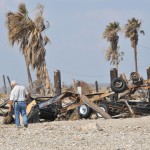

A panel studying methods to assess property loss incurred as a result of wind versus water forces along the Texas coast expects to have the first of four study components ready for consideration next month.
The mission of the Texas Windstorm Insurance Association Expert Panel is “to develop ways of determining whether a loss to TWIA-insured property was caused by wind, waves, tidal surges, or rising waters not caused by waves or surges,” according to the Texas Department of Insurance.

“The idea is to establish the hazard levels for any tropical cyclone affecting the Texas coast,” the panel’s chair, Bob Bailey, Ph.D., said during a public meeting on Dec. 10, 2013. “We also need to define the vulnerability of subject properties to damage … and ultimately estimate the consequences of that event in terms of the percent damage to the property or to the components of that property.”
The other members of the panel are Douglas A. Smith, Ph.D.; Bill Coulbourne, P.E., Sam Amoroso, Ph.D.; and Andrew Kennedy, Ph.D.
The four components of the panel’s work going forward, Bailey said, are a hazard module, a damage module, an economic loss module and a report module.
The panel’s approach “will combine existing technologies and procedures. … Each component of this methodology will have associated research or review activities to develop the full recommendations,” Bailey said. Materials and methodology will be available for public review, as well.
The initial focus will be on slab cases – structures in which only a foundation or portion of it remained following a storm. Slab claim cases were common following Hurricane Ike in 2008.
The hurricane hazards model will produce estimates of wind, storm surge and wave activity, Smith said. Information from all properties insured by TWIA that could be affected by a storm will be included in the hazards module.
“The two main components … are a hurricane wind field model and a storm surge and wave model. These models may produce their estimates of the hazard intensities and timing based on a combination of numerical simulation, measurements from field implementation, and post event observation, such as high water marks,” Smith said.
The wind field model and the storm surge/wave module must work together, he said. “The data requirements on the results from these two models must be compatible and consistent.”
The panel will take a two-pronged approach with the damage module. “The first prong we’re terming the model approach and the second prong is termed an observational approach,” Amoroso said.
“The model approach is based on vulnerability functions that we would define ahead of time for components of a building or for a building as a whole,” he said.
Basically, it studies the “relationship between the intensity of a hazard, for example wind speed or storm surge and wave intensity, and the damage associated with that hazard,” Amaroso said.
The observation of damage to surviving structures that experienced similar hazards is a key component of the observation method.
The degree of damage to “a surviving structure is related to the peak wind speed or peak storm surge level observed or estimated at a site,” Amoroso said. “If we collect many such observations we can construct a vulnerability function that can then be used in conjunction with our modeled vulnerability function to arrive at a best estimate of what the relationship between hazard level and damage is.”
By combining time histories from the hazards module with the vulnerability functions in the damage module the panel will be able to estimate when certain levels of damage would occur on a particular property, he said.
The economic loss module would then incorporate information from the damage module. Amoroso said in estimating economic loss, the panel would rely on “TWIA adjusters to determine the repair or replacement costs associated with the damage estimated by the model for affected building components.”
The adjusters, he said, will likely have better local knowledge of the monetary values for specific property components.
The report generation module will encompass the findings of the three completed modules.
“It reflects output where we summarize site specific information regarding the property, hazard information,” Bailey said. “What was the maximum storm surge height, including wave? What was the maximum gust wind speeds? And perhaps more importantly, when did these occur over time?”
At the end of the process, the panel will pull together a final report to submit to the commissioner, who can adopt all, part or none of the recommendations of the panel. Ultimately, Bailey said, the panel envisions using the information provided by the research to generate a two-part report; one part would be used by adjusters in the field and the other would be presented to the property owner.
The panel expects to present the final report with recommendations to the commissioner sometime in June.